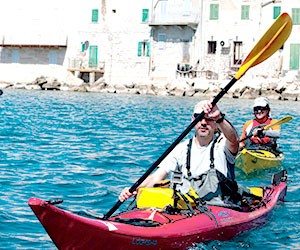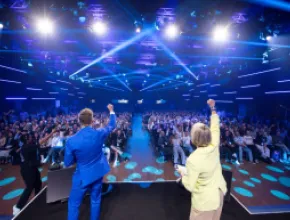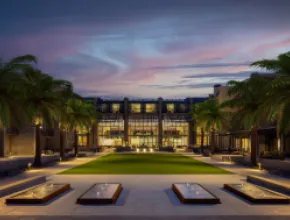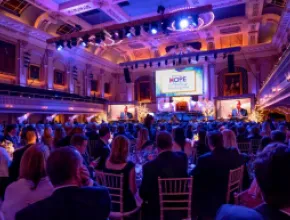From the Roman emperors who sojourned here in ancient times to the British holidaymakers thronging its shores in the 1970s and 1980s, this timeless trove of medieval walled cities, primeval forests, fertile plains, rugged mountains, intricate coastlines and 1,000-plus islands has been a visitor magnet for centuries.
After declaring independence from the former Republic of Yugoslavia in 1991, Croatia endured four years of sporadic but damaging conflict. With calm and stability fully restored in the two decades since, Croatia is squarely back on the leisure and incentive map, while also making strides in the international group market.
“Croatia is well positioned in the corporate and association markets for gatherings of up to 600 attendees,” says Meri Matesic, director of the Croatian National Tourist Board. “With the numerous North American companies and associations represented here and throughout Europe generating plenty of CEE (Central and Eastern Europe) and EMEA (Europe, Middle East and Africa) zone meetings and events in Croatia, these generally include a number of North American participants.”
Within two hours flying time from most major European international airports, Croatia’s strengths include high-quality infrastructure and hotels, historic and contemporary venues, affordability, value and eco-consciousness.
“We also offer numerous DMCs and event agencies to create and organize authentic, tailor-made group programs in all major destinations,” Matesic says.
With eight UNESCO World Heritage Sites headlining its many enchantments, Croatia’s diverse group destinations feature a rich mix of options.
Zagreb
Croatia’s artsy, youthful capital city is a Central European hub for international conferences, sporting and cultural events, and diverse smaller gatherings. Uniquely blending nearly 1,000 years of history with modernity, the city is divided along Ilica, its longest thoroughfare, into historic Upper Town and younger, more commercial Lower Town. Zagreb’s founding areas, Gradec and Kaptol, are among the best preserved in Europe.PageBreak
Enhanced by outdoor cafes, parks and an Old World ambience, this vintage-modern theme is also found in Zagreb’s leading conference hotels and congressional venues. With the 306-room Sheraton Zagreb and 378-room Westin Zagreb among the global brands, classic choices include the 209-room Regent Esplanade Zagreb and the 123-room Hotel Palace Zagreb. The Esplanade and 205-room Hotel International Zagreb are both close to the versatile Vatroslav Lisinski Concert and Congress Centre, with seating for 1,851 people in its largest hall.
Modern facilities also include Zagreb Fair Convention Centre, hosting up to 1,200 delegates, and Hypo EXPO XXI conference center, seating 1,750 in its main hall. The Golden Hall at the Croatian Institute of History and the National Revival Hall at the Croatian Academy of Sciences and Arts are evocative choices for offsite events, along with the Museum of Arts and Crafts and Illirian Hall.
Kvarner, Istria and Slavonia
Curling westward from Zagreb and central Croatia atop the Adriatic Sea, the Kvarner and Istria regions continue to mature as group destinations, with Slavonia to the east still emerging.
In Kravner, romantic Opatija hosts more than 500 congresses, seminars, meetings and events each year. Gently descending toward Kvarner Bay on the slopes of Mount Ucka, this picturesque coastal escape features the classic Hotel Kravner (1884) and its splendid Crystal Ballroom. History is also served at the 213-room Grand Hotel Palace Bellevue and 127-room Hotel Imperial, along with vintage venues such as Villa Angiolina and the Juraj Sporer Arts Pavilion.
The bustling port city of Rijeka, meanwhile, offers venues such as Conference and Exhibition Hall Transadria and the shoreline-hugging Hotel Jadran.
Often described as “Croatia’s Tuscany,” peninsular Istria entices groups with coastal locales reflecting the cultural crossings of centuries. Best known for its Roman heritage, Pula’s treasures include a three-tiered Roman amphitheater and the Gates of Hercules, with the 242-room Hotel Histria among several group properties.PageBreak
Ancient Rovinj continues to enhance its status with draws such as the recently opened 248-room Hotel Lone, a luxurious design hotel co-marketed with local sister properties such as Hotel Eden and Hotel Park for hosting large-scale gatherings.
Offshore, Brijini National Park is a spectacular 14-island archipelago with heritage attractions, hotels and group facilities.
Forming the easternmost part of Croatia, scenic Slavonia’s main center is Osijek. Set along the River Drava, the city’s group venues include the Faculty of Economics, with exhibition areas and 15 auditoriums hosting groups from 20 to 363, along with the 140-room Hotel Osijek and luxurious 16-room Hotel Waldinger.
Thought to be one of the oldest continuously inhabited cities in Europe, festive Vinkovci sits close to Sopot, one of the most important archaeological parks in Croatia.
Dalmatian Coast
Tailing southward from mountainous Lika-Karlovac, four-region Dalmatia, facing Italy across the Adriatic (the northernmost arm of the Mediterranean Sea) is where Croatia’s colorful coastal character comes to life.
Backed by the mighty Velebit Mountains, the diverse Zadar region boasts an intricately indented shoreline and more than 300 rocky islands. Settled in the 9th century on a small peninsula, the stone-walled town of Zadar offers conference hotels such as the 5-star, 210-room Hotel & Spa Iadera. Other popular locales include the coastal resort of Biograd, the royal seat of Croatia’s rulers in the Middle Ages.
Next, the Sibenek region is home to Kornati Archipelago National Park and its tempting array of islands, reefs and rugged cliffs. Photogenic, too, is the inland Krka National Park, which follows the lakes, waterfalls and other features of the Krka River.
Best known and most established for groups are Dalmatia’s two southernmost regions, Split and Dubrovnik. Featuring more than 1,000 islands and arguably Europe’s most fetching coastlines, these ancient citadels stir the imagination with UNESCO-strength appeal and Mediterranean flair.
First inhabited by the Roman emperor Diocletian around 293 AD, mountain-backed Split is a storybook bayside oasis complete with esplanades, marinas and historic squares. Prime group bases include the 101-room Atrium Hotel, built on the city’s ancient foundations, and the stylish 250-room Radisson Blu Resort Split, with versatile space for up to 700 delegates.
Other Split-area jewels include the Makarska Riviera and the famed islands of Brac, home to the heavenly Zlatni Rat (Golden Cape) beach, and glamorous, lavender-scented Hvar, where the smart 324-room Hotel Amfora offers versatile space for up to 300 delegates theater-style.
Established in the 7th century and Byzantine-ruled for five centuries before flourishing as an independent republic from 1358 to 1808, Old Town Dubrovnik dazzles with its fortified walls and authentic medieval atmosphere. Classy conference-capable properties include the 158-room Excelsior Hotel & Spa and the 194-room Hotel Lapad, both opened in 1912; the 308-room Dubrovnik Palace; and nestled in a nearby cove, the intimate Hotel Kazbek, housed in a former summer residence from 1573. mf







